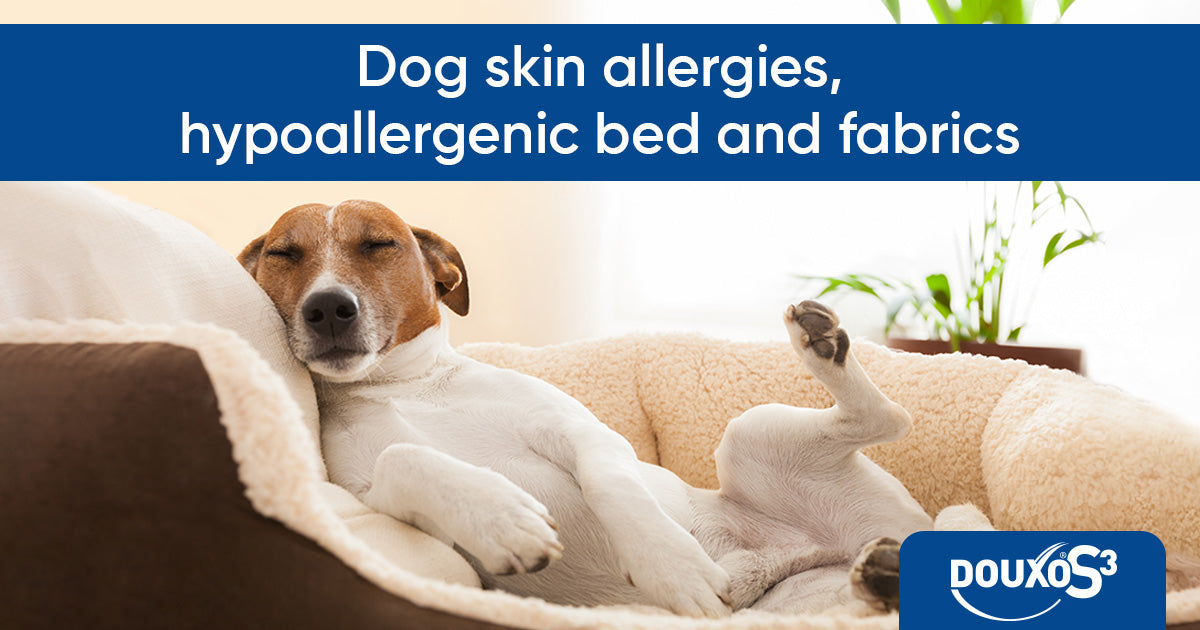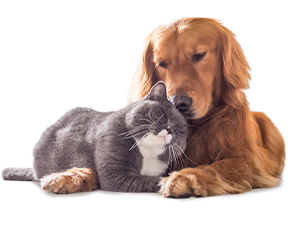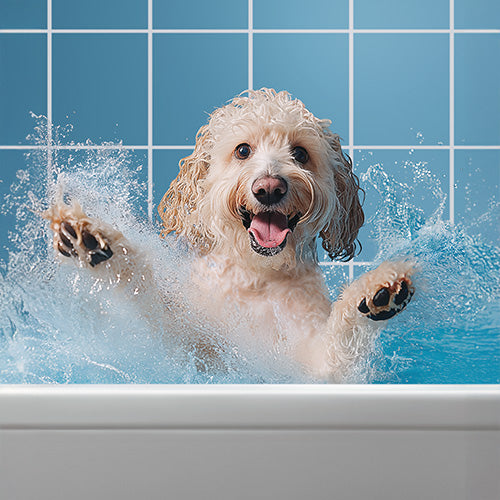
Dog skin allergies, hypoallergenic bed and fabrics
Allergic disease in dogs, also known as canine atopic dermatitis, is estimated to affect up to 15% of the canine population and it is predicted that this value is constantly on the rise. This article aims to provide an understanding of canine allergic disease and will venture into the world of hypoallergenic management – because we understand that many people will want to look at ALL the options available.
Have you ever wondered that your pet’s bedding might actually be contributing to their allergic reactions?
There are many allergens that dogs can encounter that can trigger an allergic reaction. These allergic reactions can range from mild to severe and can lead to varied levels of itchiness depending on the dog’s level of sensitivity.
Introducing Public Enemy No. 1: Dust mites
One of the most common allergens affecting dogs are house dust mites. People are often shocked to learn that house dust mites live in everyone’s homes and feed on human and animal skin dander, scales and hair. Most dogs with allergic skin disease are allergic, to some degree, to house dust mites, which are impossible to completely eradicate from home environments.
And it’s not just the bedding...
Anywhere where animal dander (dead skin cells) accumulates is likely to be a haven for these mites. In fact, some studies suggest that they and their faeces may contribute up to 10% of the weight of older bedding! But of course, it’s not just bedding. Dust mites will thrive in carpets (especially wall-to-wall, where there is that dusty bit round the edge you can’t quite clean – containing a feast for the mites!), sofas, cushions, couches, bed covers... the list goes on and on.
How we can control dust mite numbers
Well, dust mites can never really be eliminated. However, by keeping the numbers down, we can reduce your dog’s exposure to them, and limit the degree to which they are driving allergic skin problems. By having hard uncarpeted flooring, regularly hoovering and washing animal bedding, you may significantly reduce the population of dust mites and will therefore reduce your pet’s exposure. Some household sprays also help to reduce the number of house dust mites and we would recommend contacting your veterinarian for more information.
Hypoallergenic management
The term ‘hypoallergenic’ means ‘void of allergens’ and is less likely to trigger an allergic reaction. Dogs with allergies benefit from hypoallergenic management, which can be through environmental or dietary.
One of these management options includes a hypoallergenic dog bed, where the bedding textiles and materials are specifically designed to minimise allergens, therefore, and minimising allergic reactions.
Why use hypoallergenic dog beds?
There are many benefits to hypoallergenic dog beds. Not only do they minimise the number of allergens your dog is exposed to, but they also provide comfort and cushioning your dog. Many dogs with allergies are very itchy, irritable and stressed, particularly during the evenings. By using this type of bedding, it should reduce their itchiness and allow them to have a much better night’s sleep!
These beds can be sourced from many places, and they do come in a variety of shapes and sizes to be tailored towards different dog breeds.
What makes these types of bedding hypoallergenic?
Hypoallergenic beds are usually made up of cotton or tightly woven microfiber fabrics which are less likely to accumulate allergens by blocking the passage of allergy causing-dust mite waste.
Hypoallergenic fabric covers
Key to the effectiveness of a hypoallergenic bed is an impermeable – and itself hypoallergenic – outer cover. This will prevent – or at least reduce – access of dust mites into the interior, and the passage of their allergenic products (live or dead mites, faecal material, etc) out again.
However, all of this is insufficient if the product is sealed with an allergenic coating, so it needs to be manufactured with a chemical coating that is unlikely to trigger an immune response itself.
Sealed seams and covers
Even if the fabric is impermeable, you need to make sure there are no weak spots – for example, open weave seams. Dust mites are truly tiny, and can creep through apparently well-closed stitching, so a coating or covering is usually needed to make sure that there aren’t too many tiny gaps for them.
Thick, dense fillings
Traditional bedding is filled with flocking, or (in some cases) actual natural bird feathers (“down filled”) - this is a disaster, as this is just more food for the mites! In addition, the open spaces mean there’s plenty of room for dander to build up, and mites to access it for feeding.
Instead, a hypoallergenic bed will have a thick, dense or solid filling, made of an artificial (or at least highly unpalatable, to dust mites) filling. Memory foam or similar is often a good choice, as well as providing additional padding and comfort.
Which breeds may benefit from hypoallergenic dog beds?
Hypoallergenic dog beds can be safely used for any type of dog, but they do greatly benefit dog breeds predisposed to skin allergies. These breeds include Chinese Shar-peis, brachycephalic breeds such as pugs, French Bulldogs and Bulldogs, Shih Tzus, Boxers and West Highland White Terriers. Brachycephalic breeds are predisposed to fold dermatitis due to their excess skin and wrinkles. These skin folds create the ideal moist environment for bacterial growth, leading to irritation, inflammation and infection of the skin.
Other management options
You may be wondering whether using a hypoallergenic bed is the only solution to managing your dog with allergies. Whilst hypoallergenic beds contribute to reducing the huge dust mite exposure within households, a multi-pronged approach to managing your dog’s allergic condition is often required. This includes dietary management, sometimes allergy medication and topical treatments.
DOUXO® S3 CALM is a topical product aimed at dogs with itchy, irritated and sensitive skin. This product comes in different forms including shampoo, mousse and pads, depending on owner preference and dog tolerance. DOUXO® S3 CALM has an anti-itch action and can bring significant relief to irritated skins. This can be used both for prevention and treatment. Contact your veterinarian for more information regarding these products.
To conclude, if you own a dog with underlying allergies, it is definitely worth exploring a hypoallergenic bed if you’ve not already. It may help to improve your dog’s overall comfort and itchiness levels, which is our main overall aim in allergy management.
We recommend DOUXO® S3 CALM

















